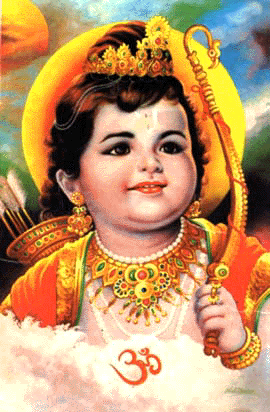SHRI RAMA AVATAR
From the illustrious pages of
Sant Tulsidas' Ramcharitamanas
(Chnd) Bhae pragata krpala parama dayala kausalya hitkari (Chnd) kaha dui kara jori astuti tori kehi bidhi karaun ananta (Chnd) bramhanda nikaya nirmit maya roam roam prati veda kahai (Chnd) mata puni boli so mati doli tajahu tata yaha rupa (Doha) graha graha bajbadhava subha pragateau susamakanda (Chp) kaikaya suta sumintra dou (Chp)avadhapuri sohai yehin bhanti (Chp)agara dhupa urrai abira manahun arunari (Doha)masadivasa kar divasa bha marama na janay koi
Sruti says: Chakravarti Rajagopalachari in translating Vaalmeeki's Raamaayana for the Bharatiya Vidya Bhavan wrote: GO TOP
Harasit mahatari munimanhari adbhuta rupa bichari
Lochana abhirama tanu ghana syaman nija ayudha bhuja chari
Bhusana banamala nayana bisala sobha sindhu kharari
maya guna gyana tita amana veda purana bhananta
karuna sukha sagara sab guna agara jehi gavahinsruti santa
so mama hita lagi jna anuragi bhaye pragata sri kanta
mama ura so basi yaha uphasa sunata dhira mati thir na rahai
upaja jab jnana prabhu musukana charita bahuta bidhi kinha chahai
kahi katha suhai matu bujhai jehi prakara sutaprema lahai
kijai sisulila ati priyasila yaha sukha parama anupa
suni bachana sujana rodana thana hoi balaka surabhupa
yaha charita je gavahin haripada pavahin te na parahin bhava kupa
Bhae pragata krpala .....
harasavanta saba jahan tahan nagara nari nara branda (#194}
sundra suta janamata bhain ou
voha sukha sampati samaya samaja
kahi na sakai sarada ahiraja
prabhuhi milana aie janu rati
dekhi bhanu janu mana sankuchani
tadapi bani sandhya anumani
kautuka dekhi patanga bhulana
eka masa taye jata na jana
ratha sameta rabi thakeu nisa kavana bidhi hoi(#195)
Om poornamadah poornamiddam poornai poornamudachyate poornasya poornamadaaya poornamevaavasishyate
"The traditional orthodox view is that Vaalmeeki wrote the Raamaayana during the lifetime of Raamchandra. Judging from normal experience, however, it would appear that the story of Raama had been in existence, though not as a written work, long before Vaalmeeki wrote his epic. It looks as though Vaalmeeki gave form to a story that had been handed down from generation to generation."
Rama, however, is not portrayed by Valmiki in his Sanskrit Ramayana as an avatar or incarnation of God, although in several chapters there is reference to Rama as an avatar.
In my view, this, however is not only reasonable but understandable as a very normal reaction by normal people. Today, there are those who refer to Sai Baba as an "avatar" and during the earlier centuries after the crucifixion of Christ, not many thought of his as the son of God. Fact is, there are people alive today who still think of Martin Luther King and Mahatma Ghandi as "incarnations". Frankly, it is said that it takes all kinds to make this world .... so, take your pick.
But even during Valmiki's time, the idea of Rama avatar or Vishnu's incarnation as Rama and also, Krishna was not only prevalent, but there were Rama's devotees and temples and mandirs scattered throughout.
Sant Tulsidas (1573-75) became one such devotee and although he used Valmiki's Sanskrit Ramayana as the base for his Ramcharitmanasa, he introduced several modifications and presented Shri Ramchandra Ji as a full fledged avatar of Vishnu.
Rama as an incarnation of God is also supported in Thailand in the Ramakien, which is regarded as the "most authentic version of Ramayana", according to Prof. Ohng toru.
To dull-witted me, the lyric of the verses above when meditated upon whilst chanting actually transform and completely transports one to the glorous lotus feet of Vishnu himself, and this feeling leaves little, if any, for one to imagine Kausalya's state of mind when Vishnu manifested himself before her.
In part, says Tulsidas:
"The thought of His marvellous form, which stole the heart of sages, filled the mother with joy. His body was dark as a cloud, the delight of all eyes, in His four arms He bore His characteristic emblems ... a conch-shell, a discuss, a club and a lotus. Adorned with jewels and a garland of sylvan flowers and emdowed with large eyes, the slayer of the demon Khara was an ocean of beauty.
Joining the palms of her hand, Kausalya said:
"O infinite Lord, how can I praise You! The Vedas as well as the Puranas declare You as transcending Maya, beyond attributes, above knowledge and beyond all measure. He who is sung by the Vedas and holy men as an ocean of mercy and bliss and the repository of all virtues, the same Lord of Laksmi, the lover of His devotees, has revealed Himself for my good. The Vedas proclaim that every pore of your body contains multitudes of universes brought forth by Maya. That such a Lord stayed in my womb .. this amusing story staggers the mind of even men of wisdom."
It is THAT FORM that is to this day to dear to Hindus throughout the World and it is the strength of Tulsidas' Rama and Sita that continues to guide them, wherever they are.
Seya barr Ramchandra ki Jai

ENTER SHARMA'S HUT
Guide to Religious Articles
